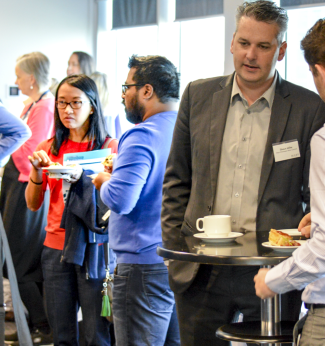Making the space for place
5 Apr 2018
Easter means hot cross buns, easter eggs, going away and... the Smart Urban Futures conference!
A diverse crowd gathered in Melbourne before Easter to explore ways to build more liveable, healthy and sustainable communities.
Peter Jones from the UK, originator of the Link and Place approach to street design, told us that the share of trips undertaken by car in London has dropped from 46% to 32% in two decades. He talked about the importance of moving away from 'predict and provide' transport planning, where you assume everyone will continue to drive in a growing city and try to build roads accordingly. We need a 'vision and validate' system, where we decide what we want our city to look like and then make transport decisions to deliver it.
Andrew Wall from VicRoads talked about their approach in adapting Link and Place. He pointed out that Swanston Street in the CBD, with no cars but plenty of trams, pedestrians and bike riders, was moving as many people as the Westgate Bridge.
Acclaimed Perth-based transport and environment expert Peter Newman helped us see the realities of cities today. He pointed out that every one of them is, in practice, a combination of walking city, transit city and auto city, "but the traffic manual only sees one." He noted that the walking city needed buildings right on the street (no setbacks) and highly restricted car parking. He also said that in crowded cities, moving to forms of transport that use street space efficiently (like Swanston Street) was about "making the space for place."
Space was also on the mind of Dr Libby Gallagher from Cool Streets. In a session dedicated to street trees and landscaping, she pointed out that in new suburbs with small lots and tiny back yards, the biggest space we have for greenery - and the only place suitable for decent sized trees - is the street.
In a robust session on fostering progressive leadership, a panel of councillors and an executive engaged in a frank discussion with the audience on the realities of communication between councillors and staff. Apparently council staff need to know who their councillors are!
Visiting from MRCagney in New Zealand, economist Peter Nunns talked about the 'Big Lie' of transport economics - the suggestion that time savings for people in vehicles directly translate into monetary economic benefits. Most people caught in congestion aren't on a work trip - their inconvenience is not a cost to business. Take those headlines saying 'congestion costs the economy $X billion' with a very large grain of salt.
Peter talked about work done for Auckland Council to measure the 'cost' of congestion - but for pedestrian congestion and delay, not vehicles. Using standard measurements of 'congestion costs' the cost of pedestrian delay was estimated at NZ$2.7 million p/a, for just one CBD intersection!
The sit-down part of the conference was concluded with a set of quickfire presentations of best practice:
- Lisa Monaghan outlined Brimbank City Council's new high quality pedestrian infrastructure in the Sunshine town centre.
- Simon Wilson from Development Victoria talked us through the award-winning Junction Place development in Wodonga.
- Anna Purvis from the City of Yarra gave us a sneak peak at the first broad 30km/h speed limit trial approved in Victoria.
- Che Sutherland from the City of Darebin showed us their innovative method for prioritising new pedestrian crossings.
Fittingly, the conference ended with a Walkshop, exploring innovative approaches to street design in the suburb of Albert Park, hosted by the City of Port Phillip.
For more information:
- View the conference presentations
- Check out the conference program
- Video of presentation from Ben Rossiter - 'The dog ate my walking strategy'
The Smart Urban Futures conferences are an ongoing collaboration between Victoria Walks and the Municipal Association of Victoria.